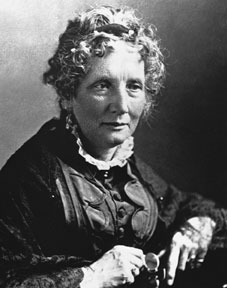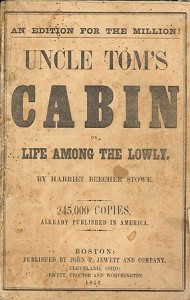
Harriet Beecher Stowe
A Hawley Descendant
HARRIET BEECHER STOWE
Born: 14 June 1811, Litchfield, Connecticut
Died: 1 July 1896, Hartford, Connecticut
Harriet Beecher Stowe would be celebrating her 202nd today. The Hawley Society’s 2010 Reunion was held in Cincinnati and we visited her home there. Due to her significance to American history, we know quite a bit about her life.
Hawley Connection
Less generally known is that she was a descendant of the Connecticut Line of the Hawley family. Her father was Lyman Beecher and he was the son of David Beecher and Esther Hawley Lyman. Esther’s parents and Harriet’s Great Grandparents were John Lyman and Hope Hawley. Hope was the daughter of Jehiel Hawley and Hope Stowe. Jehiel’s parents were Samuel Hawley, son of Joseph, and Mary Thompson.
The Harriet Beecher Stowe House in Cincinnati is the former home of her father, Lyman Beecher. Beecher was a Doctor of Divinity and moved to Ohio to lead the Lane Seminary. The home was supplied by the Seminary. Harriet lived in the house from the time the family moved to Cincinnati until her marriage to Calvin Stowe. Today, the house is open to the public and operated as a historic cultural site presenting African American history including the Underground Railroad, as well as Harriet and the Lane Seminary.

The family felt strongly about education and Harriet and her sisters received educations more typically reserved for the male children in the family.
In 1833,shortly after her family’s arrival, Harriet visited a community near Maysvlle, Kentucky to avoid a cholera epidemic in Cincinnati. She stayed with the family of one of the students of Lane Seminary. While there she witnessed a slave auction which affected her deeply. She was also exposed to the treatment of slaves working on plantations in the South. She was further affected by a series of pro-slavery riots in Cincinnati during 1836. Although she wrote UNCLE TOM’S CABIN after leaving Cincinnati, it is commonly held that her inspiration came from her experiences while there. Upon meeting President Lincoln, he said to her, “So you’re the little lady that started the War.”
Obituary
Hartford, Connecticut
Writer, Social Reformer. The author of UNCLE TOM’S CABIN, an antislavery novel of such power that it is cited among the causes of the American Civil War, Harriet Beecher Stowe was also an advocate of women’s rights, religious tolerance, and educational reform. She was the daughter of Lyman Beecher, a well-known religious leader, and the former Roxana Foote, a devout woman who died when Harriet was 4 years old. Although painfully shy and considered an “odd” child, she was intellectually gifted, and received an excellent education at a school founded by her elder sister Catharine.
In 1832 she moved to Cincinnati, Ohio, where her father had been appointed head of a local seminary, and in 1836 married Calvin Stowe, a widowed biblical scholar who taught at the school. The next 14 years proved stressful, with Harriet giving birth to 6 of their 7 children, including a set of twins. Often in ill health and deeply grieved by the loss of a child to cholera, she struggled to supplement her husband’s meager income with her writing.
These hardships deepened her empathy with the suffering of others, however, and life in close proximity to Kentucky, a slave state, provided her with the material for “Uncle Tom.” While visiting the South she had witnessed the brutality of the plantation system first-hand, and she also housed fugitive slaves in her home.
In 1850, her husband’s appointment to the faculty of Bowdoin College brought her to Brunswick, Maine, and it was here that Mrs. Stowe wrote her masterpiece, galvanized by the passage of the newly enacted Fugitive Slave Law, which criminalized the assistance of runaways. When UNCLE TOM’S CABIN appeared in book from in 1852, it swiftly became both controversial and an international bestseller. Denounced by its critics as Abolitionist propaganda, it was lavishly praised by such literary giants as Tolstoy, Hugo, and Heine, and catapulted its author to fame at home and abroad.
After the Emancipation Proclamation, Stowe focused greater attention on other social reforms. Her subsequent literary efforts fell short of “Uncle Tom’s” success, although her 1869 biography of Lady Byron generated almost as much controversy for its allegations of incest. Personal tragedy also stalked her family, claiming the lives of 3 of her adult children, among them her son Frederick, an alcoholic war veteran, who disappeared without a trace in 1870. Her nephew, the distinguished soldier Frederick Beecher, had been killed 2 years earlier in the Indian Wars battle which bears his name.
Widowed in 1886, Stowe’s elder years were spent in Hartford, Connecticut, where she enjoyed the neighborliness of Mark Twain and Oliver Wendell Holmes, and occasionally, a little too much wine. “I won’t be any properer than I have a mind to be,” said the octogenarian authoress. When she died at 85, survivors included her unmarried twin daughters, her youngest son, and her favorite brother, the celebrated Henry Ward Beecher. (bio by: Nikita Barlow)
Burial: Philips Academy Cemetery, Andover, Essex County, Massachusetts
.png)


